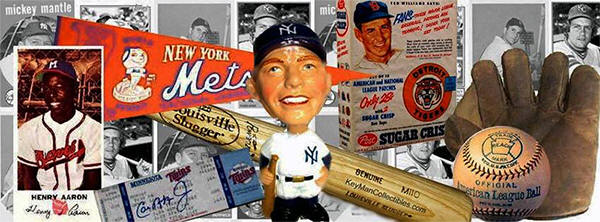 |
|
|
|
1930-1939 CATCHER'S MASK DATING GUIDE |
| |
Heavy Carbon steel wire
is now being used.
Ridged 5/8" round
bars are replacing the
"wire mesh" masks.
Double and triple
wiring with Truss
construction is
becoming more common as
well as, padding laced
to to the frames.
Padded chin rests are
replacing the leather
chin pads. |
|
|
| Visual Glossary |
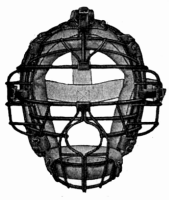 |
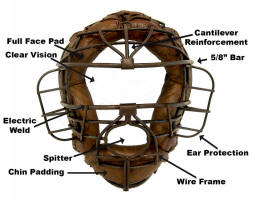 |
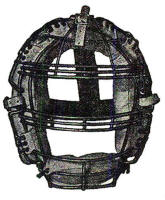 |
1930 Spalding HDB-1
Catchers Mask |
1930-1939s 5/8" Two Bar
catchers mask with Round Spitter |
1937 Triple Wire Two Bar
Constructed Catchers
Mask |
|
|
| |
The Dating of a catcher's
mask could prove to be a
difficult task.
Construction styles,
models, or features could
have been used for many
years after they were
introduced. In some cases
you could positively date a
mask to after a feature was
first introduced but you
might have to settle on
generalizing the dating to
a longer era of use. Most
of the model introduced in
the late 1920s, carry over
into the 1930's and some
are developed with only the
slightest changes by the
end of the decade. The
thick 5'8" heavy wire two
Bar mask are becoming a
favorite design which
allows for better vision
for the catcher. Frames
with two, "eye space bars"
each made with Triple wire,
is being introduced in 1930
and is developed throughout
the decade. Truss
construction frames with
spitters dominate the
market. Extended wire ear
protections is also
becoming more common. |
|
|
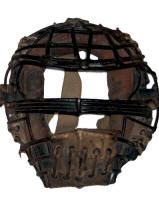 |
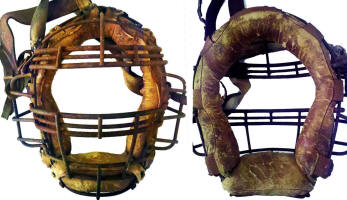 |
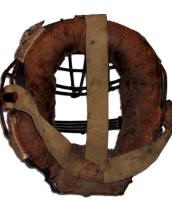 |
Extra
Reinforced
"Safety First" Model |
1930's -1940's
Triple Wire Two Bar construction
with ear protection. |
"Safety
First" model with extra reinforced wire large Chin Pad |
|
| |
A few loop &
clip construction masks are still being sold but most
of them are youth models. The development of the one
piece "Light Metal" catchers masks introduced
in 1921 seems to come to a halt with one basic model
being sold by all the major manufactures. Instead the
design is taken in the direction of a one piece molded
frame with two eye space bars affixed to it. The
majority of masks have Chin padding but like the loop
and Clip frames, some models still use
the simple chin rests. Again mostly with youth models. The use
of lacing to secure the face padding to the frame is
more evident.
Basically the main features with masks dated to the
1930-1939 manufacturing period are; Wide Sight truss
construction, triple wire electric weld frames, heavy
5/8" two bars eye space, extended wire ear protection,
and chin padding. You will also notice more lacing being
used to secure the face pads to the frame.
Because it is easier to date a mask to the era when a
feature was available I have listed a timeline below.
You might be able to use unique features on your mask
that overlap other features to narrow down the date. I
have also included catalog images so you can match
styles and construction characteristics like a
fingerprint. |
|
|
|
Catchers Mask Timeline |
- 1911 D&M introduces Electric
Welded steel wire construction.
- 1912 Reach introduces "Wide Sight"
frame construction.
- 1914 Reach introduces "The Spitter"
hole
- 1914 The first use of chin padding
that slowly replaces chin support straps.
- 1916 Spalding starts to use Truss
Support, and double wire construction.
- 1921 Aluminum one piece frame is
patented by umpire James E. Johnstone.
- 1930 Two, "eye space bars" each
constructed with three wires is patented.
- 1935 One piece molded frame with
two "eye bars" affixed to it is patented
|
|
1930-1939 Catchers Mask Catalog Samples & Ads |
|
|
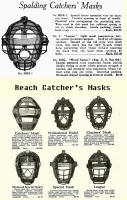 |
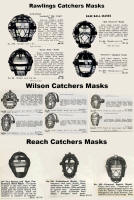 |
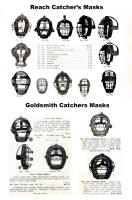 |
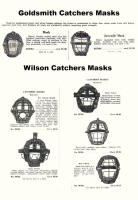 |
1930 Spalding - 1931 Reach
Catchers Masks |
1930 Rawlings Wilson Reach
Catchers Masks |
1930-1936 Reach Goldsmith
Catchers Masks |
1934 Goldsmith & Wilson
Catchers Mask advertising |
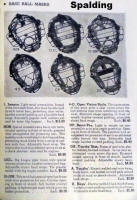 |
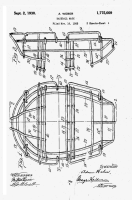 |
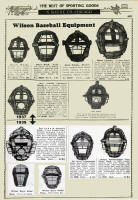 |
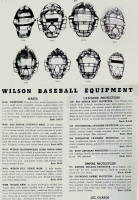 |
1935 Spalding
Catchers Masks |
1930 Triple wire two Bar
Catchers Mask Patent |
1937-1939 Wilson
Catchers Masks |
1939 Wilson
Catalog ad |
|
|
|
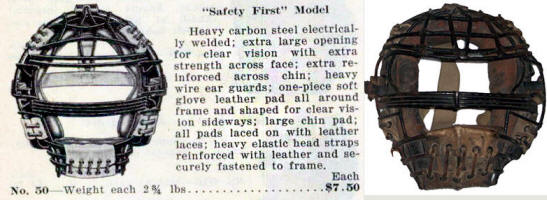 |
|
1930 Rawlings "Safety First" Catchers Mask Model No. 50 |

